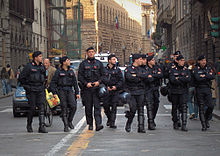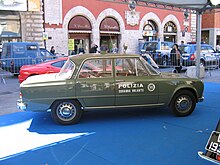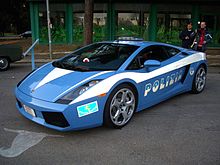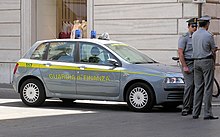Law enforcement in Italy: Difference between revisions
Wehnam F. R. (talk | contribs) rollback to the July 16 version |
|||
| Line 118: | Line 118: | ||
[[Polizia Provinciale]] operate in all of in all of the 109 [[Provinces of Italy|provinces of Italy]]. In addition, [[Polizia Regionale]] operate in five of the [[Regions of Italy#Autonomous regions with special statute|autonomous regions]]. Their main duties are to enforce regional and national [[hunting]] and [[fishing]] laws but have also expanded into [[wildlife management]] and environmental protection. The forces' vehicles are white with a green stripe along the side. |
[[Polizia Provinciale]] operate in all of in all of the 109 [[Provinces of Italy|provinces of Italy]]. In addition, [[Polizia Regionale]] operate in five of the [[Regions of Italy#Autonomous regions with special statute|autonomous regions]]. Their main duties are to enforce regional and national [[hunting]] and [[fishing]] laws but have also expanded into [[wildlife management]] and environmental protection. The forces' vehicles are white with a green stripe along the side. |
||
In addition, each comune has its own ''[[Polizia Municipale]]'' ([[municipal police]]) who deal with petty crime, anti-social behaviour and so on. In some regions of Italy these forces can also be called ''Polizia Urbana'', |
In addition, each comune has its own ''[[Polizia Municipale]]'' ([[municipal police]]) who deal with petty crime, anti-social behaviour and so on. In some regions of Italy these forces can also be called ''Polizia Urbana'', or ''Vigili Urbani''. |
||
In some regions [[Polizia Provinciale]] and [[Polizia Municipale]] are grouped into the [[Polizia Locale]] name, although they keep their own internal organisation. |
|||
Furthermore, the Coast Guard (''[[Guardia Costiera]]'') provides law enforcement on the sea and is part of the Italian Navy (''[[Marina Militare]]''). |
Furthermore, the Coast Guard (''[[Guardia Costiera]]'') provides law enforcement on the sea and is part of the Italian Navy (''[[Marina Militare]]''). |
||
Revision as of 21:42, 29 July 2008

Law enforcement in Italy is provided by five separate national police forces:
 Arma dei Carabinieri (military police),
Arma dei Carabinieri (military police),
- File:Forestale coat of arms.jpg Corpo Forestale dello Stato (forestry police).
 Guardia di Finanza (financial and customs police, also organized as a military force),
Guardia di Finanza (financial and customs police, also organized as a military force),
 Polizia di Stato (state police),
Polizia di Stato (state police),
- File:Polizia penitenziaria coat of arms.jpg Polizia Penitenziaria (penitentiary police)
and three sub-national police forces:
- Polizia Provinciale in the 109 provinces of Italy
- Polizia Regionale in five of the autonomous regions
- Polizia Municipale in some comunes
In some areas Polizia Provinciale and Polizia Municipale are grouped into Polizia Locale.
Police officers are not permitted to enter the Italian Parliament unless out of session and the speaker has given his or her consent.
Arma dei Carabinieri

The Carabinieri is the common name for the Arma dei Carabinieri, a Gendarmerie-like military corps with police duties. They also serve as the Italian military police.
The Carabinieri recently became a separate armed force (alongside the Army, Navy and Air Force), thus ending their long standing tradition as the First Corps (Arma) of the Italian Army (Esercito). They are referred to as the Arma or La Benemerita (The Meritorious Corps), and are unrivalled in popular affection and national pride, although they are often subjects of jokes about their intelligence, because requirements to be a Carabiniere used to be very low (elementary-school level). Though the requirements are now higher, the stereotype persists.
In recent years Carabinieri units have been dispatched all over the world in peacekeeping missions, including Kosovo, Afghanistan and Iraq.
In 2004, twelve Carabinieri were killed in a suicide bomb attack on their base in Nasiriyah, in southern Iraq. This was Italy's largest military loss in a single action since World War II.
Previously, only men were allowed to become part of the Arma (or any military force, for that matter), but recent military reforms allow women to serve in the Italian military, including Carabinieri.
Guardia di Finanza
The Guardia di Finanza is a special Italian police force at the service of the Ministry of the Economy and Finance. The Guardia di Finanza is a Military Corps and is an integral part of the Italian Armed Forces as well as of the law enforcement agencies. Its duties primarily involve investigating money-related crimes, such as tax evasion, financial crimes, customs and border checks, money laundering, smuggling, international drugs trafficking, Terrorist Financing, illegal immigration, credit cards frauds, anti-mafia operations and money counterfeiting. Their functions overlap somewhat with some of the duties of the following American agencies: the IRS, the FBI, DEA, U.S. Secret Service and U.S. Customs. The Guardia di Finanza has a naval fleet for the overseeing of territorial waters, and an air force.
The special departments of the Guardia di Finanza are:
- Gruppo di Investigazione Criminalità Organizzata (GICO): Organized Crime Investigation Group.
- Gruppo Operativo Antidroga (GOA): Counter-narcotics Group.
- Gruppo Anticrimine Tecnologico (GAT): Counter-cybercrime Group.
- Comando Operativo Aeronavale : Air-Naval Operational Command.
- AntiTerrorismo Pronto Impiego (ATPI): Antiterrorism and Rapid Response Service.
Polizia di Stato
The Polizia di Stato (State Police) is the National Police of Italy. Along with common patrolling, investigative and law enforcement duties, it is responsible for patrolling the Autostrada (Italy's Express Highway network), and overseeing the security of railways, bridges and waterways.
It is a civilian police force, while the Carabinieri are military. While its internal organization and mindset is somewhat military, its personnel is composed totally of civilians. Its headquarters are located in Rome, and there are Regional and Provincial divisions scattered throughout Italian territory.
In recent years, a new program called Polizia di Quartiere was implemented which aimed at increasing police presence and deterring crime. Pairs of poliziotti (policemen) or carabinieri patrol specific areas of major cities on foot. Its critics contend that these efforts are ineffective, as the areas with the greatest concentration of crime are being neglected.
Polizia Penitenziaria
The Polizia Penitenziaria (Prison Guards, literally Penitentiary Police) operate the Italian prison system and handle the transportation of inmates.
Corpo Forestale dello Stato
Similar to Park Rangers in the US, the Corpo Forestale dello Stato (National Forestry Department) controls Italian national parks and forests. Their duties also include fighting poachers, safeguarding protected animal species and preventing forest fires.
Special corps
Some forces have their own special corps, with more specific duties. The most common are listed below, among with a brief description and with their American counterpart, where possible.
- Carabinieri:
- Corazzieri: Honor guard located in the Quirinale palace to protect the President. They have almost no other everyday duties, although they may be seen patrolling occasionally.
- Gruppo di Intervento Speciale (Special Intervention Group): Special operations team employed in counter-terrorism and other high risk missions. Their training is similar to that of British SAS and the German GSG 9.
- Nucleo Tutela Patrimonio Artistico (Artistic Patrimony Protection Group): Their duty is to safeguard the artistic patrimony of Italy and retrieve stolen art works.
- Nucleo Anti Sofisticazioni (Sanitary Enforcement Group): Their duty is to enforce sanitary laws.
- Reparti Investigazioni Scientifiche (Scientific Investigative Division). Forensic police, same as the US Crime Scene Investigation.
- Raggruppamento Operativo Speciale: Often involved with organized crime investigations and other undercover operations. A ROS operative, usually known only by his callsign (Captain Ultimo) commanded the team that arrested the notorious Mafia boss Salvatore "Totò" Riina.
- Polizia di Stato:
- Nucleo Operativo Centrale di Sicurezza (Central Security Operations Group): It can be compared with the American SWAT.
- Polizia Postale (Postal Police): Their nearest American counterpart is the U.S. Postal Inspection Service although they also fight cybercrime.
- Polizia Stradale (Highway Police): Its American counterpart is the Highway Patrol.
- Polizia Ferroviaria The Railroad police that protects trains and train stations.
- Guardia di Finanza:
- Gruppo di Investigazione Criminalità Organizzata (Organized Crime Investigation Group): A specialized department of the Guardia di Finanza.
- Gruppo Operativo Antidroga (Counter-Narcotics Group) of the Guardia di Finanza.
- Gruppo Anticrimine Tecnologico (Counter-Cybercrime Group) of the Guardia di Finanza.
- Comando Operativo Aeronavale (ROAN): Air-Naval Operational Command of the Guardia di Finanza.
- Two or more agencies:
- Reparto Cinofili (Police Dog Division) is the Italian for K9. The Polizia, Carabinieri, Guardia di Finanza, Corpo Forestale dello Stato and Polizia Penitenziaria all have their own canine units.
Transportation



Until recently, all Italian police forces were equipped with Italian-made cars. The most famous of them, the Alfa Romeo Giulia, gave the nicknames of the cars still commonly used today. A patrol car belonging to Polizia is nicknamed Pantera (Panther), one used by the Carabinieri is nicknamed Gazzella (Gazelle) and every unmarked car is called a Civetta (Owl).
Every force has also helicopters, trucks and campers (used as mobile offices usually in undercover missions). In Venice, which is built across several islands linked by bridges and surrounded by water, public security and fire brigades work with boats. In 2004, Lamborghini donated two Lamborghini Gallardos police car - fully equipped with lights and sirens and capable of travelling at almost 310 km/h - to the state police on the occasion of their 152nd anniversary. This car is used for fast delivery of plasma and organs for transplantation.
Carabinieri patrol vehicles are very dark blue (almost black) with a red stripe along the side. Their normal civilian law enforcement vehicles have registration plates beginning with "CC" whereas vehicles for military police duties have military plates beginning with "EI".
The PdS’s vehicles are light blue with a white stripe along the side and the word Polizia in large letters underneath. The license plates also start with the word Polizia in red usually followed by a letter and four numbers.
The GdF’s vehicles are dove grey or dark blue with a thin gold stripe along each side and the words Guardia di Finanza in gold underneath. The vehicle plates begin with the letters “GF” in red.
The CFS’s vehicles are green with a white stripe and the words Corpo Forestale dello Stato in white along the side. The vehicle plates begin with the letters “CF” in red.
Polizia Penitenziaria vehicles are dark blue with a light blue stripe along the side and Polizia Penitenziaria in white letters under the stripe.
Other police forces

Polizia Provinciale operate in all of in all of the 109 provinces of Italy. In addition, Polizia Regionale operate in five of the autonomous regions. Their main duties are to enforce regional and national hunting and fishing laws but have also expanded into wildlife management and environmental protection. The forces' vehicles are white with a green stripe along the side.
In addition, each comune has its own Polizia Municipale (municipal police) who deal with petty crime, anti-social behaviour and so on. In some regions of Italy these forces can also be called Polizia Urbana, or Vigili Urbani.
In some regions Polizia Provinciale and Polizia Municipale are grouped into the Polizia Locale name, although they keep their own internal organisation.
Furthermore, the Coast Guard (Guardia Costiera) provides law enforcement on the sea and is part of the Italian Navy (Marina Militare).
Historical secret police organizations
- Organizzazione di Vigilanza Repressione dell'Antifascismo (OVRA) (Organization for Vigilance in Repression of Anti-Fascism)

